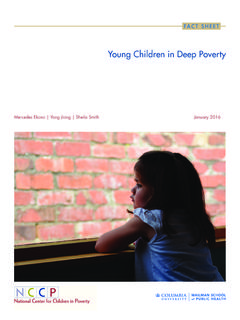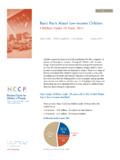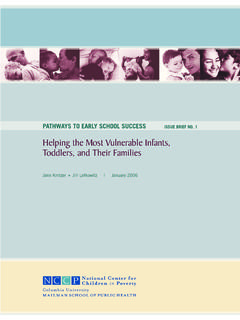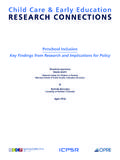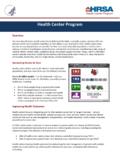Transcription of Children’s Mental Health: Facts for Policymakers
1 children 's Mental health : Facts for Policymakers NOVEMBER 2006. Mental health is a key component in a child's healthy A greater proportion of children and youth in the development. children need to be healthy in order child welfare and juvenile justice systems have Mental to learn, grow, and lead productive lives. There are health problems than children and youth in the effective treatments, services, and supports that can general population. help children and youth with Mental health problems 50% of children and youth in the child welfare sys- and those at risk to thrive and live successfully. Most tem have Mental health children and youth in need of Mental health services do not receive them. 67% to 70% of youth in the juvenile justice system have a diagnosable Mental health children 's Mental health Problems are Widespread Mental health System Inadequate to Meet Needs of children and Youth Mental health problems occur commonly among today's youth1 and begin at a young Most children and youth with Mental health problems do not receive needed services.
2 One in ve children has a diagnosable Mental 75% to 80% of children and youth in need of men- One in 10 youth has serious Mental health problems tal health services do not receive that are severe enough to impair how they function at home, school, or in the Mental health services and supports vary depending on the state in which a child or youth with Mental The onset of major Mental illness may occur as early health needs lives. as 7 to 11 years There is a 30% difference between the states with Factors that predict Mental health problems can be the highest and lowest unmet need for Mental health identi ed in the early services (51% to 81%).13. children and youth from low-income7 households Latino children and youth are less likely to receive are at increased risk for Mental health problems.
3 Services for their Mental health problems than 21% of low-income children and youth ages 6 children and youth of other ethnic groups. through 17 have Mental health 31% of white children and youth receive Mental 57% of these low-income children and youth come health from households with incomes at or below the fed- 13% of children from diverse racial and ethnic back- eral poverty grounds receive Mental health 88% of Latino children have unmet Mental health needs. (See Figure 1.)16. National Center for children in Poverty 215 West 125th Street, 3rd oor New York, NY 10027-4426. 646-284-9600 National Center for children in Poverty 2. children 's Mental health : Facts for Policymakers Most children and Youth with Mental health Figure 1: Unmet children 's Mental health needs, by race/ethnicity Problems Struggle to Succeed children and youth with Mental health problems have 88% 90%.
4 Lower educational achievement, greater involvement 76% 77%. with the criminal justice system, and fewer stable and longer-term placements in the child welfare system than children with other disabilities. When treated, children and youth with Mental health problems fare better at home, schools, and in their communities. White Black Latino Other Source: Kataoka, S.; Zhang, L.; & Wells, K. (2002). Unmet need for Mental Preschool children face expulsion rates three times health care among children : Variation by ethnicity and insurance status. American Journal of Psychiatry, 159(9), 1548-1555. higher than children in kindergarten through 12th grade a factor partly attributed to lack of attention to social-emotional African-American preschoolers are 3 to 5 times more Even some children and youth with the most intense likely to be expelled than their white, Latino, or needs and some who are insured do not receive services.
5 Asian-American 85% of children and youth in need of Mental health services in the child welfare system do not receive children and youth in elementary school with men- tal health problems are more likely to be unhappy at 79% of children with private health insurance and school, be absent, or be suspended or expelled. 73% with public health insurance have unmet In the course of the school year, they may miss as Mental health needs. (See Figure 2.)18 many as 18 to 22 Their rates of suspension and expulsion are three Figure 2: Unmet Mental health needs of children , times higher than their by insurance status Among all students, African-American students are more likely to be suspended or expelled than their 87% white peers (40% vs. 15%).24. 79%. 73%. Youth in high school with Mental health problems are more likely to fail or drop out of school.
6 Up to 14% of them receive mostly Ds and Fs (com- pared to 7% for all children with disabilities).25. Uninsured Private insurance Public insurance Up to 44% of them drop out of Source: Kataoka, S.; Zhang, L.; & Wells, K. (2002). Unmet need for Mental health care among children : Variation by ethnicity and insurance status. American Journal of Psychiatry, 159(9), 1548-1555. Youth in the child welfare and juvenile justice systems with Mental health issues do less well than others. children with Mental health issues in the child wel- A gap also exists between need and treatment for fare system are less likely to be placed in permanent youth with substance use disorders that sometimes occur with Mental health problems. They are also more likely to be placed out of home Less than 10% of the over million youth be- in order to access tween 12 through 17 years of age who needed They are more likely to over rely on restrictive and/.
7 Substance abuse treatment in 2004 received specialty or costly services such as juvenile detention, residen- facility-based substance abuse tial treatment, and emergency National Center for children in Poverty 3. children 's Mental health : Facts for Policymakers Young adults leaving the child welfare system experi- Endnotes ence major Mental health problems and drug and This fact sheet was prepared by Rachel Masi and Janice Cooper. alcohol dependence at signi cantly higher rates than the general 1. children ages 12 17 are classi ed as youth in this fact sheet. 2. New Freedom Commission on Mental health . (2003). Achiev- ing the promise: Transforming Mental health care in America. Final Effective Public Policy Strategies to Enhance report (DHHS Pub. No. SMA-03-3832). Rockville, MD: Department of health and Human Services, Substance Abuse and Mental health for children , Youth, and Mental health Services Administration < Their Families mission.
8 Gov/ >. 3. Ibid. Improve access to Mental health consultation with 4. Ibid. a speci c focus on young children . Preschools with 5. Kessler, R. C.; Beglund, P.; Demler, O.; Jin, R.; & Walters, E. E. access to Mental health consultation have lower (2005). Lifetime prevalence and the age-of-onset distributions of expulsion DSM-IV disorders in the National Comorbidity Survey Replica- tion. Archives of General Psychiatry, 62(6), pp. 593-602. Coordinate services and hold child- and youth- 6. Knitzer, J. & Lefkowitz, J. (2006). Helping the most vulnerable serving systems accountable. Robust service coor- infants, toddlers, and their families (Pathways to Early School Success dination in the child welfare system reduces gaps Issue Brief No. 1). New York, NY: National Center for children in Poverty, Columbia University Mailman School of Public health .
9 In access to services between African-American and 7. The current federal poverty level for a family of 4 is $20,000. white children and Low-income families make up to twice that amount. For more Provide Mental health services and supports that information on measuring poverty, see NCCP's state pro les at < > and the Department of health and Human meet the developmental needs of children . Treat- Services < >. ment and supports designed using a developmental 8. Howell, E. (2004). Access to children 's Mental health services under framework are more likely to respond to the changing Medicaid and SCHIP. Washington, : Urban Institute. needs of children and 9. Ibid. Apply consistent use of effective treatments and 10. Burns, B.; Phillips, S.; Wagner, H.; Barth, R.; Kolko, D.;. Campbell, Y.
10 ; & Yandsverk, J. (2004). Mental health need and supports. A range of effective treatments exist to access to Mental health services by youths involved with child help children and youth with Mental health prob- welfare: A national survey. Journal of the American Academy of Child lems to function well in home, school, and commu- and Adolescent Psychiatry, 43(8), pp. 960-970. nity 11. Skowyra, K. R. & Cocozza, J. J. (2006). Blueprint for change: A comprehensive model for the identi cation and treatment of youth Engage families and youth in their own treatment with Mental health needs in contact with the juvenile justice system. planning and decisions. Family support and fam- Delmar, NY: The National Center for Mental health and Juvenile Justice (NCMHJJ) and Policy Research Associates, Inc.
